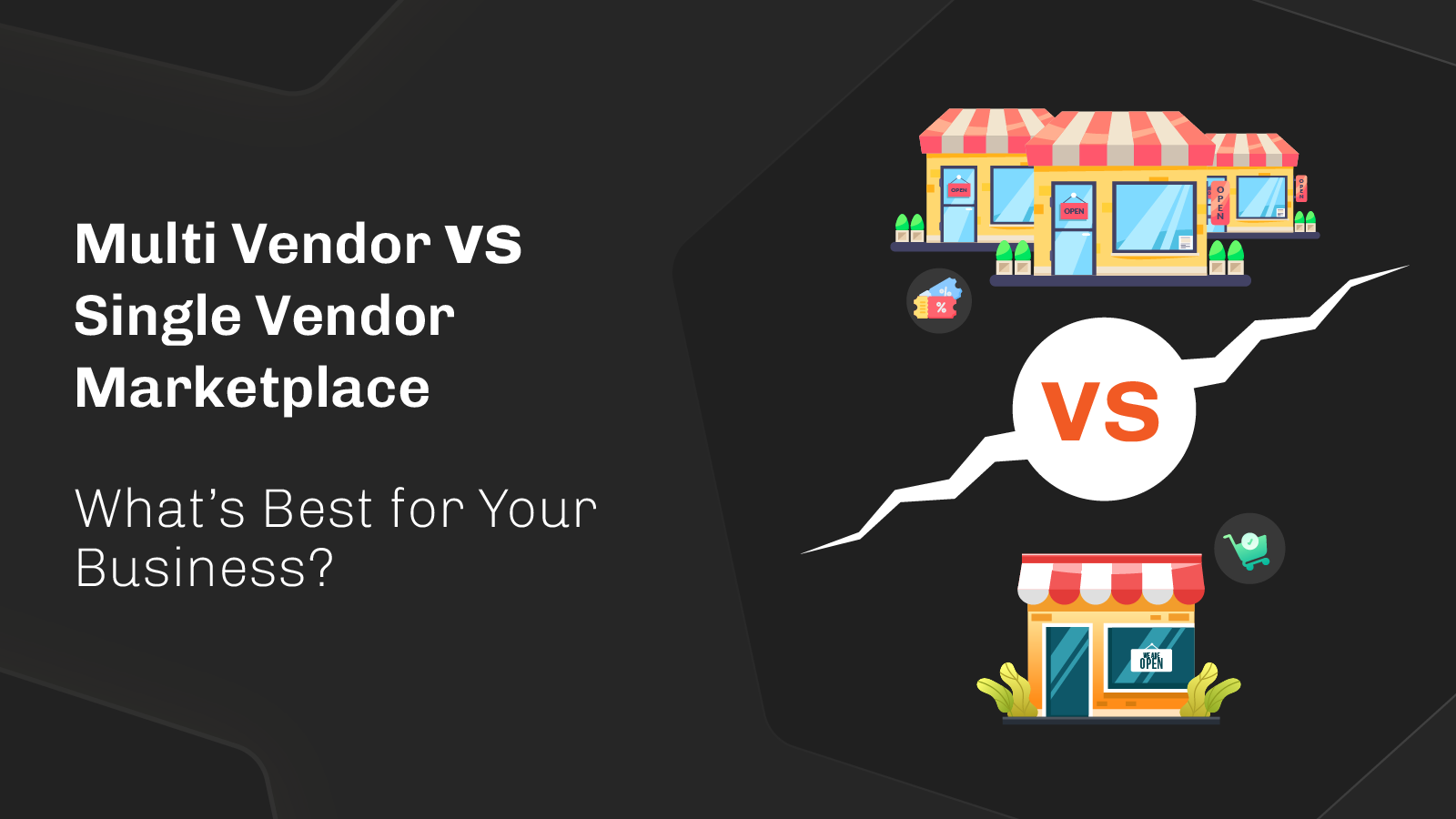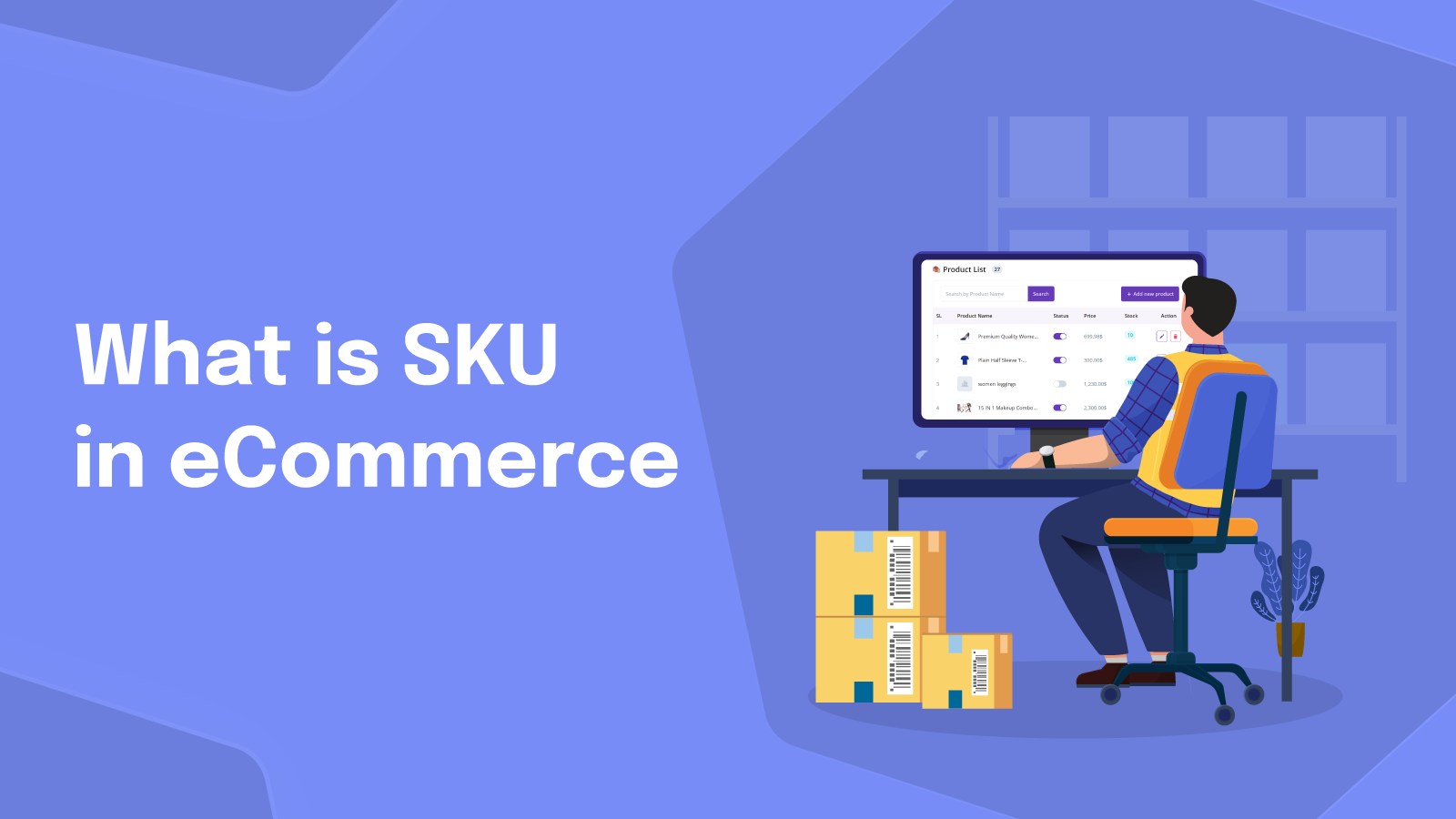Even after several decades, the demand and growth of eCommerce are continuously skyrocketing. Depending on the marketplace type, businesses are adapting different models to thrive in the competitive eCommerce ecosystem.
And why not?
Both single vendor and multi vendor marketplaces come with their own set of advantages and disadvantages. They both offer businesses distinct opportunities and challenges to navigate in their quest for online success.
So, if you’re an aspiring businessman searching for complete information about “multi vendor marketplace vs single vendor marketplace” on the internet tirelessly – you’ve landed in the right place.
This blog explains details about single vendor and multi vendor marketplace so that you can easily choose the right marketplace for your business.
Let’s get started!
What is A Single Vendor Marketplace?
In a single-vendor marketplace, there is only one seller who provides goods or services to customers.
They decide what to sell, set prices, and deal with customer inquiries & orders. So, the total marketplace is under the seller’s control, from product listing and pricing to customer support.
One of the most well-known examples of a single vendor marketplace is Apple’s online store, where you can purchase Apple products directly from Apple.
What is A Multi Vendor Marketplace?
An online marketplace that allows multiple vendors to sell their goods or services to consumers is known as a multi vendor marketplace.
In a multi vendor marketplace, many sellers are selling different items. Here customers have access to a wide range of products from different sellers, all in one place. Joining a multi vendor marketplace helps sellers reach more people. They can tap into the platform’s existing customer base. Also, they benefit from the marketplace’s infrastructure already in place.
Popular platforms like Amazon and Etsy are notable examples of multivendor marketplaces where multiple independent sellers offer their products to customers.
Also Read: eCommerce Business Ideas to Get Started
Multi Vendor Marketplace vs Single Vendor Marketplace – What Are The Differences?
Now let’s discuss the differences between multi vendor marketplace and single vendor marketplace. Although both platforms serve consumers, at the end of the day, the business model sets them apart from each other.
| Aspect | Multi Vendor Marketplace | Single Vendor Marketplace |
| Ownership | Owned by a company allowing multiple sellers. | Owned by a single company. |
| Range of Products | Wide range of products from various sellers. | Exclusive products from one seller. |
| Control of Seller | Each seller manages products, prices, and inventory depending on permission from the admin. | The single owner controls all aspects. |
| Competition | Sellers with similar products compete for customers. | No competition as there’s only one seller. |
| Client Satisfaction | Diverse product selection and comparing options. | A curated selection from a single source with no option to compare. |
| Branding | Sellers have individual branding and marketing options. | The platform’s brand is prominent. |
| Scalability | Easily scalable with the addition of more sellers. | Growth is tied to the success of single vendor. |
| Revenue Model | Revenue from commissions/fees. | Revenue from direct sales. |
| Development Complexity | Requires complex integration for multiple seller support. | Comparatively easier as it solely focuses on single seller development. |
Table: Multi Vendor Marketplace Vs Single Vendor Marketplace
Understanding and having a clear idea about the differences between these two marketplaces will help you make informed decisions and choose the right platform for your business needs.
Also Read: Choose the Right PHP Laravel Source Code
Pros and Cons of Multi Vendor Marketplace and Single Vendor Marketplace
To make a quick, objective, and considerate decision while choosing between multi vendor and single vendor eCommerce website it’s important to weigh up the benefits and drawbacks.
The benefits of one model can be proven as an issue for your business model and vice versa. So a clear idea and consideration are needed to decide between one.
Pros and Cons of Multi Vendor Marketplace
Let’s have a quick look at the pros and cons first before we dive into the details-
| Pros | Cons |
|---|---|
| ✅ Diversified Products ✅ Competitive Pricing ✅ Reduced Risk ✅ Scalability ✅ Adapting to Demand Shifts | ✅ Complex Management ✅ High Development Cost ✅ Quality Control ✅ Brand Dilution ✅ Conflict Resolution |
Pros of Multi Vendor Marketplace:
- Diversified Products: Multi-vendor marketplaces are a smart choice for businesses looking to expand their customer base and increase their revenue. These platforms can attract more customers and grow their business by offering a diverse range of products and sellers.
- Competitive Pricing: As more and more sellers offer similar products, the competition to attract customers becomes increasingly intense. However, this has led to an increase in competitive pricing, deals, and discounts, ultimately benefiting the admin, seller, and customer.
- Reduced Risk: Having multiple sellers on a single platform reduces the risk of depending on a particular one for a particular product. So, if one seller is facing troubles, the platform can run smoothly by handling changes and challenges without big problems for any platform stakeholder.
- Scalability: Multi vendor marketplaces are the perfect solution for businesses that are looking to scale quickly and efficiently. By adding new vendors, these platforms offer unparalleled opportunities for growth and expansion.
- Adapting to Demand Shifts: When multiple vendors are supplying a particular product, it helps in managing the demand fluctuations for that product over different periods. This is because the different vendors can adjust their product volumes based on the demand, ensuring the marketplace stays stable. For example, if one vendor is unable to meet the demand for a particular product during a specific period, the other vendors can step in and supply the product, thereby maintaining the stability of the marketplace.
Cons of Multi Vendor Marketplace:
- Complex Management: It’s challenging and requires a lot of time to manage multiple sellers and ensure quality standards for each.
- High Development Cost: Building and maintaining a multi-vendor marketplace can require a substantial amount of money to be invested in developing the platform from scratch, which can result in higher initial costs.
- Quality Control: Managing and maintaining quality across multiple vendors can be quite challenging. It may lead to variation in product quality.
- Brand Dilution: While sellers may desire their own unique branding, marketplace leaders should be cautious as this could detract from the overall brand identity and cause confusion among consumers.
- Conflict Resolution: It’s not uncommon for disagreements to arise between sellers or between sellers and customers. When conflicts occur, it’s essential to have effective mechanisms in place to resolve them.
Pros and Cons of Single Vendor Marketplace
Before we delve into the details, let’s have a brief overview of the advantages and disadvantages of a marketplace with a single vendor –
| Pros | Cons |
|---|---|
| ✅ Unified Branding ✅ Direct Control ✅ Direct Revenue ✅ Quality Assurance ✅ Streamlined Processes | ✅ Limited Product Variety ✅ Risk of Dependency ✅ Lack of Competition ✅ Slower Product Upgrades ✅ Growth Limitation |
Pros of Single Vendor Marketplace
- Unified Branding: In a single vendor marketplace, the branding stays the same across the entire platform. This means everything looks and feels the same when customers explore and shop. It makes the navigation easier for customers to understand and navigate.
- Direct Control: Admin makes all the decisions in this type of marketplace which makes things run smoother. The admin can set the fees, prices, and any extra charges on the platform. They have complete control over everything.
- Direct Revenue: Selling directly to customers gives businesses greater control over their revenue, allowing for more flexibility in pricing strategies and higher profit margins.
- Quality Assurance: As single vendors or businesses are solely responsible for product quality, they can ensure consistent standards and customer satisfaction.
- Streamlined Processes: Everything runs more smoothly in a single vendor marketplace. You’re mainly dealing with your own team, so it’s simpler to coordinate tasks, manage supplies, and communicate effectively. This makes the whole process easier and more efficient.
Cons of Single Vendor Marketplace
- Limited Product Variety: As customers get products from one particular seller, their choice range of products is limited.
- Risk of Dependency: In a single vendor marketplace, the entire marketplace depends on the success of the single vendor. If the vendor experiences any disruptions or failures, it could ripple effect on the entire marketplace. This could result in lost revenue, negative customer experiences, and damaging the marketplace’s reputation.
- Lack of Competition: Without competition, sellers may become complacent and fail to improve their products, resulting in a lack of innovation.
- Slower Product Upgrades: Since there’s only one vendor, product updates and improvements may take longer to implement, leading to slower innovation and product development.
- Growth Limitation: Relying on a single vendor for success hampers the capability to grow and expand, limiting scalability.
Factors to Consider When Choosing Between Single Vendor and Multi Vendor Marketplace
When it comes to choosing the right marketplace for your business, there are several factors that you should keep in mind to make an informed decision:
– Type of products or services you offer
– The target audience
– Competition
– Scalability
– Revenue model
Deciding between a single vendor and multi vendor marketplace involves careful consideration of multiple factors-
Product Variety: Single vendor marketplaces offer products from just one seller, while multi vendor ones have many sellers. Depending on the marketplace model you choose, the variety of products differs. Think about the range of products you want to offer to your customers.
Competition: Multi vendor marketplace has more competition compared to a single vendor, as multiple sellers offer products or services. Consider if this will help or hurt your business. Going for a single vendor would be wiser if you want no competitors for your business.
Control: In a single vendor marketplace, you have complete control over everything. But in a multi vendor one, you have to work with different sellers and in some cases, be under the admin’s control. Think about how much control of your business you want while choosing.
Cost: Developing and setting up a single vendor marketplace might be cheaper initially, but you’ll need to consider the long-term costs and benefits. Developing a multi vendor marketplace from scratch may seem like a daunting task. However, opting for a cost-effective and comprehensive solution can offer significant benefits.
Customer Experience: Consider how each option will affect your target customers’ shopping experience. Will they prefer a wide selection of products or a more focused, curated collection?
Carefully considering these factors will help you make the best decision for your business.
Which marketplace is best for you?
Now if you’re still confused and can’t decide which marketplace is best for you, then –
- Consider a single vendor marketplace If you want complete control over your products and services without any competitors.
- Consider a multi vendor marketplace if you prefer a wide selection of products by being in a competitive environment and reaching a wider range of audience.
But how about having both at the time same time? If you’re wondering if it’s possible in reality, then be assured that there’s a complete solution out there.
6Valley is a comprehensive eCommerce solution that supports both multi vendor and single vendor business models. As an admin, you get the option to choose what type of business you want and switch between the models at your convenience.
6amTech’s Solutions According to Single or Multi Vendor Marketplace
Now let’s have a look at the solutions offered by 6amTech that serve different business models:
| Solution Name | Multi Vendor Marketplace | Single Vendor Marketplace |
| 6amMart | ✅ | |
| 6Valley | ✅ | ✅ |
| StackFood | ✅ | |
| eFood | ✅ | |
| Demandium | ✅ | |
| Grofresh | ✅ | |
| Hexacom | ✅ |
Table: Multi Vendor Marketplace Vs. Single Vendor Marketplace within 6amTech’s Solutions
Know More: eCommerce Software Solutions
Final Words
That wraps up today’s discussion. I hope you got the detailed idea and decision-making criteria for the multi vendor marketplace vs single vendor marketplace. Remember to set your business goal and have a clear idea about your target audience as choosing between a single vendor and multi vendor marketplace depends on both.
By considering the unique advantages and disadvantages of single and multi vendor eCommerce solutions, you will be able to find the right one for you.
See you in the next blog!
FAQs
Can I switch between a single vendor and a multi vendor setup on the same platform?
Yes, with the 6Valley eCommerce CMS Solution, there comes an option of switching between single vendor and multi vendor setup for admin at the same platform.
How can I attract sellers to join my multi vendor marketplace?
To attract sellers to your multi vendor marketplace, offer competitive commission rates, provide robust seller tools for easy management, and showcase success stories from existing sellers. Additionally, focus on targeted marketing campaigns to reach potential sellers and highlight the benefits of joining your platform. You can also use a business landing page to turn visitors into leads.
What is the difference between a single vendor and a multi vendor marketplace?
In a single vendor marketplace, one seller manages all products, while in a multi vendor marketplace, multiple sellers offer products. Single vendors offer limited variety, while multi vendors provide diverse choices.



















